
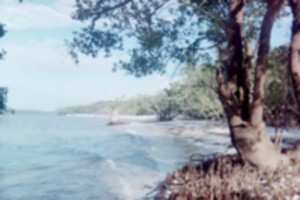 Nine of us from New College of Florida, in Sarasota, departed just before sunrise on Saturday, January 5th. We drove south on I75 to Collier-Seminole State Park. We unloaded our gear, food, and boats, filled up our water jugs, and reviewed compass usage and paddling technique. Then we set off down the Blackwater River toward Whitehorse Key.
Nine of us from New College of Florida, in Sarasota, departed just before sunrise on Saturday, January 5th. We drove south on I75 to Collier-Seminole State Park. We unloaded our gear, food, and boats, filled up our water jugs, and reviewed compass usage and paddling technique. Then we set off down the Blackwater River toward Whitehorse Key.
The first night at Whitehorse was nice. The white beach was covered in large, whole shells and mangled, weathered trees. It was dark when we arrived, so we cooked dinner and went to bed early.
The next morning, we woke up on our own. Around dawn, the skies were clear and the breeze calm, but shortly after the dark clouds began to move in and the winds picked up. When is started to rain we discussed what to do if we sighted lightning, backed our boats and left.
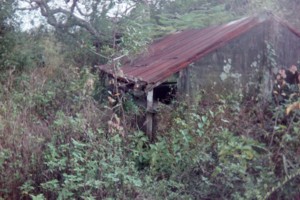 The bad weather blew over pretty quickly. We stopped at Dismal Key, a deserted shell mound that used to be home to man that was now gone. His cistern, outhouse, house and other buildings were being reclaimed by the plants of the area. We wandered around and looked at the Everglades Tree Snail, th Gumbo Limbo Trees, cactus, wild Poinsettia, and many other plants.
The bad weather blew over pretty quickly. We stopped at Dismal Key, a deserted shell mound that used to be home to man that was now gone. His cistern, outhouse, house and other buildings were being reclaimed by the plants of the area. We wandered around and looked at the Everglades Tree Snail, th Gumbo Limbo Trees, cactus, wild Poinsettia, and many other plants.
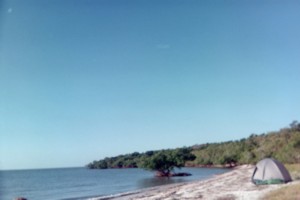
After lunch we left for Panther Key, named when a previous resident encountered some panthers that ate his goats early last century. The beach there was nice, many dead and dying Australian pine lined the outer portion of it.
The next day we crossed the choppy bay and round a few islands to arrive at Camp Lulu, the home of Mike Ward. He had a very nice setup for visitors, with a guest kitchen and guest outhouses. There were trails around the Red Mangrove of the island and a narrow, but high strip of beach to camp on.
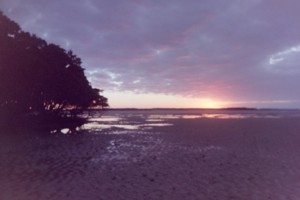
We had a bit of trouble getting out the next morning due to the low tide. The island was surrounded by mud flats that made it difficult for us to get our boats to the water. We had risen well before sunrise hoping for an early start, but did not leave until a bit after the sun was in the sky and the water had approached the beach.
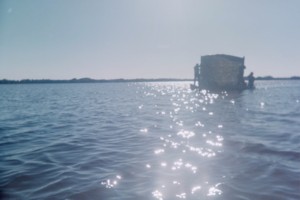 We paddled toward Chokoloskee, since we were to receive a resupply of food and water there the following morning. We sailed through Chokoloskee Bay with our tarp catching wind and pulling our canoe raft along. That night we boarded up in a little alcove off of the bay, near the channel.
We paddled toward Chokoloskee, since we were to receive a resupply of food and water there the following morning. We sailed through Chokoloskee Bay with our tarp catching wind and pulling our canoe raft along. That night we boarded up in a little alcove off of the bay, near the channel.
After getting the resupply, seeing civilization for the first time in five days, and dropping off one of our group members, we began down the channel into Everglades National Park towards Kingston Key Chickee. It was a nice, six person wood platform in the water, but we had eight people. Two individuals had to stay on a raft in the water at all times, including while we ate and slept.
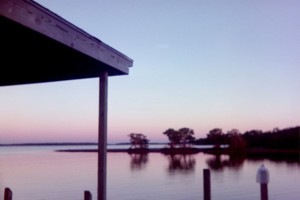
We woke up the following morning to a long paddle ahead. We were to go from Kingston Key to Pavilion Key. The Gulf was very clam that day, fortunately, making the trip quite nice. It was warm today, though it got quite cool the past few nights. We stopped and had lunch at Rabbit Key, more than halfway to Pavilion.
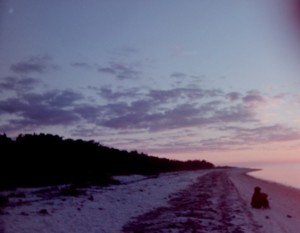
Pavilion was a nice campsite with Port-O-Lets and beaches most of the way around. I took a walk around it at sunrise the next morning and found out how big the island really was. The silt that has settled there, and around most of the islands, after the dredging of Lake Okeechobee is very sticky and, if youíre not careful, will suck your foot right in. I learned that the hard way, more than once.
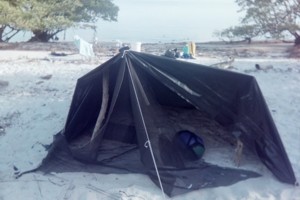 On day seven, we went on solo for 24 hours. We were alone on part of the island where we could not see anyone else. We built our own tents with a paddle, some pea cord, a piece of plastic, and a little bit of netting to keep out the mosquitoes. On the beach the mosquitoes arenít too bad, but in any woodsy area, they swarm.
On day seven, we went on solo for 24 hours. We were alone on part of the island where we could not see anyone else. We built our own tents with a paddle, some pea cord, a piece of plastic, and a little bit of netting to keep out the mosquitoes. On the beach the mosquitoes arenít too bad, but in any woodsy area, they swarm.
When we returned from our isolation, we had lunch and left just before sunset for Lostmanís River. This is a 13 to 15 mile paddle from Pavilion that we did during the night. At one point, the weather began to look bad. Dark clouds were approaching from the horizon and there was not many places that we could stop if things got bad, but we decided to paddle as fast as we could and attempt to make it to Lostmanís anyway.
We traveled though a bay with alligator grunts surrounding us, then in the adjacent bay, we encountered a capsized rowboat with an eerie life jacket dangling beside. We paddled on. Eventually, we came to an old campsite near the mouth of Lostmanís and decided to stop there for the evening.
The next day was long as well, but this time it was in daylight. We headed toward Watsonís Place in the Chatham River, previous home to the infamous E. J. Watson. There was a nice dock with Poinciana trees on either side and a Port-O-Let right by the water. Remains of the foundation of his house, his cistern, water pump, and various farming tools form his great sugar cane plantation can be found there.
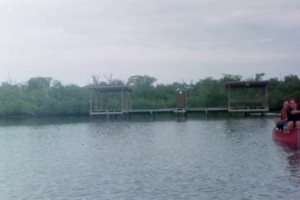 Our final destination was the Sunday Bay Chickee. This was another wood structure in the water. It was a nice, protected area of water. It looked like a potential place for alligators, however, we only saw three small gators total on the trip, and those were in bays along the Wilderness Waterway.
Our final destination was the Sunday Bay Chickee. This was another wood structure in the water. It was a nice, protected area of water. It looked like a potential place for alligators, however, we only saw three small gators total on the trip, and those were in bays along the Wilderness Waterway.
The skies in the Everglades were more clear than any I had ever seen. Endless stars blanketing the sky. The colors of the sunrise and sunset were vibrant and clear. Birds of all shapes and sizes flew in flocks of a hundred while chirping their own tune. We planned our days around the tide and the flow of nature. We rose with the sun, and generally rested with its set. The Everglades is a pleasant escape form the modernized technological world.


 Nine of us from New College of Florida, in Sarasota, departed just before sunrise on Saturday, January 5th. We drove south on I75 to Collier-Seminole State Park. We unloaded our gear, food, and boats, filled up our water jugs, and reviewed compass usage and paddling technique. Then we set off down the Blackwater River toward Whitehorse Key.
Nine of us from New College of Florida, in Sarasota, departed just before sunrise on Saturday, January 5th. We drove south on I75 to Collier-Seminole State Park. We unloaded our gear, food, and boats, filled up our water jugs, and reviewed compass usage and paddling technique. Then we set off down the Blackwater River toward Whitehorse Key.
 The bad weather blew over pretty quickly. We stopped at Dismal Key, a deserted shell mound that used to be home to man that was now gone. His cistern, outhouse, house and other buildings were being reclaimed by the plants of the area. We wandered around and looked at the Everglades Tree Snail, th Gumbo Limbo Trees, cactus, wild Poinsettia, and many other plants.
The bad weather blew over pretty quickly. We stopped at Dismal Key, a deserted shell mound that used to be home to man that was now gone. His cistern, outhouse, house and other buildings were being reclaimed by the plants of the area. We wandered around and looked at the Everglades Tree Snail, th Gumbo Limbo Trees, cactus, wild Poinsettia, and many other plants.


 We paddled toward Chokoloskee, since we were to receive a resupply of food and water there the following morning. We sailed through Chokoloskee Bay with our tarp catching wind and pulling our canoe raft along. That night we boarded up in a little alcove off of the bay, near the channel.
We paddled toward Chokoloskee, since we were to receive a resupply of food and water there the following morning. We sailed through Chokoloskee Bay with our tarp catching wind and pulling our canoe raft along. That night we boarded up in a little alcove off of the bay, near the channel.


 On day seven, we went on solo for 24 hours. We were alone on part of the island where we could not see anyone else. We built our own tents with a paddle, some pea cord, a piece of plastic, and a little bit of netting to keep out the mosquitoes. On the beach the mosquitoes arenít too bad, but in any woodsy area, they swarm.
On day seven, we went on solo for 24 hours. We were alone on part of the island where we could not see anyone else. We built our own tents with a paddle, some pea cord, a piece of plastic, and a little bit of netting to keep out the mosquitoes. On the beach the mosquitoes arenít too bad, but in any woodsy area, they swarm.
 Our final destination was the Sunday Bay Chickee. This was another wood structure in the water. It was a nice, protected area of water. It looked like a potential place for alligators, however, we only saw three small gators total on the trip, and those were in bays along the Wilderness Waterway.
Our final destination was the Sunday Bay Chickee. This was another wood structure in the water. It was a nice, protected area of water. It looked like a potential place for alligators, however, we only saw three small gators total on the trip, and those were in bays along the Wilderness Waterway.